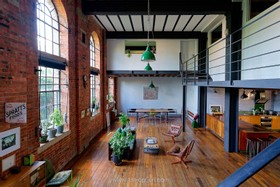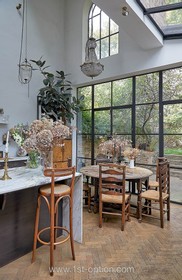A dining room, simply, is a room in which meals are eaten, a room in which people will dine. Dining rooms can be completely separate from other rooms, or they can be found as their own areas in open-plan domestic spaces. Other names of reference for spaces that are part of an open-plan area include ‘dinette’ and ‘salle a manger’. A separate dining room can be referred to as a ‘dining hall’, or historically (and mostly in reference to those in monasteries and convents in modern times) a ‘refectory’ room.
These rooms and spaces can be used for consuming all types of food, including breakfast, lunch, dinner and desert. They are also commonly used for socialising and special occasions, such as holiday dinners (New Years, Christmas, Thanksgiving etc.)
History of Dining Rooms
Like most modern interior features, only the wealthy had access to the luxury of a dining room throughout history.
According to historic sources, the Ancient Greeks were among the first to establish eating in a secluded space with increased comfort; this practice, they believed reinforced class and status. The Greeks would gather in the evening, reclining comfortably on a few couches, made of stone or wood, and eat nutritious food while discussing life matters, such as philosophy and romance
In the Western world, people began sitting on chairs, stools and benches for dining from the mediaeval period onwards. They would also eat from tables, as opposed to the reclining style of the Ancient Greeks, and a majority of the wealthy Mediterranean population. Until around the 1700s, those who lived in large houses would dine in great halls, accompanied by the house lord or the other most highly-ranked person, plus any other high-status guests they may have invited over. Banquets would also be hosted with plenty of people, typically for holidays and other special occasions, just like contemporary dinner parties.
Looking a little further into how class played into these banquets, parties and regular dinners, seating arrangements were typically thought-out and considered. Your class status and your personal relationship to the house lord were both factors that would influence if you were sat on a bench or a chair, as well as your position on the table. Although this isn’t the general norm now, and typically isn’t out-right considered in the regular family home, these underlying rules from the past can be found to be echoed in more formal parties - those with a high number of guests and events such as weddings.
In the Victorian times, dining rooms were more often decorated with crockery, ornaments and furniture with plush upholsteries. At this point in time, simply having a dining room was apparently not enough to establish your wealth and status; opulent interiors, quality utensils, table manners and etiquette were the ways of validating this. This allowed a clear distinction between the uber-wealthy and the poor.
Dining Rooms Now
It goes without saying that, despite some classic historic similarities, dining rooms have evolved over the years, and interior trends are prevalent in the modern world.
In the western world, open and broken-plan styles have become an increasingly popular trend. Alongside the popularity of renovations, knocking walls down to open up the space (or separate them only with smaller, less dense structures) has also risen in favourability. However, since the COVID-19 pandemic, it is apparent that more people are valuing their need for privacy in different areas of the house; as a result of this need, the dining room has become more sought-after in 2022 modern homes.
Not only does the modern dining room act as an eating, socialising and entertaining space, but some choose to double-up and make use of it as a home office or study, especially since the number of people working and studying from home has drastically increased.
Considering the above, some up-to-date trends for the dining room include comfortable and accommodating seating, as well as oversized lighting for decoration and convenience. Walls that depict nature imagery/ art have also popped up as a trend, heading towards a more light and airy space as opposed to dark and opulent. This can be particularly useful if spending a lot of time working from home.
Dining Rooms at 1st Option
At 1st Option, we have such a wide variety of dining rooms and styles, some of which are open-plan and some which exist in their own dedicated seclusion.
Traditional, beautiful dining rooms can be found at Cedar Court, Essex House, Henley House and Swan Court. For something traditional but grand, take a look at the outstanding Somerly, Raynham Hall, Grace and Dallington.
If you’re looking for more contemporary styles of open-plan dining spaces, you may find what you’re seeking at the wonderful Albion, Boston, Carlo, Cuva and Eltham Court, all of which are based in and around the London area.
For smaller, more convenient dinettes, Fournier Street, Frenchie, Isabella and Ivory have some humble but unique spaces and furniture.




















































































































































































































































































































































































































































































































































































